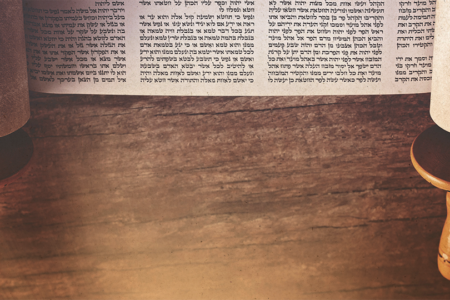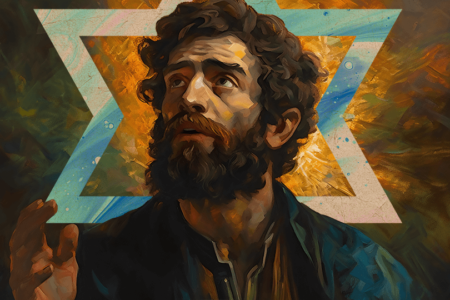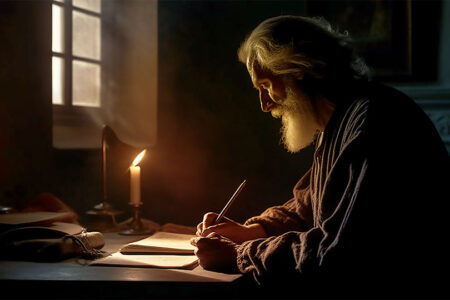‘Moshiach Is Here!’
Most Jewish people don’t believe in a Messiah. But some believe he already came as a New York rabbi.
“I believe with perfect faith in the coming of the moshiach [Messiah], and though he may tarry, still I await him every day.”
So states the Jewish sage Maimonides’ 12th Principle of Faith. Interestingly, some Jewish people believe the Messiah is already here.
Early on a Monday morning in February, my wife, Alice, and I began our drive from Chicago back home to Philadelphia. As I entered the expressway, I noticed a giant billboard with a picture of a smiling old man with a long beard and a fedora. Next to him were three statements:
MOSHIACH IS HERE.
Just add in goodness and kindness.
LONG LIVE THE REBBE KING MESSIAH FOREVER!
“He’s ba-a-ack,” I said.
“Who’s back?” Alice asked, glancing up from her phone.
“The rebbe, Schneerson—he’s back. That billboard says so.”
The Man They Called Messiah
Menachem Mendel Schneerson, better known as “the Rebbe,” led the Lubavitcher Chabad movement of Orthodox Judaism from his headquarters in Brooklyn, New York, from 1951 until his death in 1994 at age 92. Even on his deathbed, his followers still venerated him; and many began calling him the Messiah. Now, it appears, that messianic association is being revived.
Schneerson had a unique pedigree. He was last in the line of exclusive Lubavitcher Chabad rebbes dating back to 18th-century Russia. He possessed great intellect, earning a degree in electrical engineering. His followers testified of his Solomonic wisdom, as well as his compassion. He was a visionary, transforming a small Hasidic sect into a thriving global network of schools, community centers, synagogues, and charities.
Schneerson grew Chabad, an Orthodox Jewish community, into one of the most widespread and vibrant Jewish organizations in the world. To effectively become Judaism’s public face, Chabadniks (followers) became Jewish missionaries, reaching out to backslidden or nonobservant Jews to bring them into the fold of Orthodoxy. They stand on street corners around the world offering tefillin (phylacteries), prayer books, and tutelage for Jews curious about ritual observance.
Stories of great miracles are attributed to the Rebbe, such as healing the sick and causing the infertile to bear children. He was known to accurately prophesy, and his words were deemed powerful enough to change the weather. So great was his reputation that some were calling him the Messiah.
In 1991, the Rebbe, then 89, issued what Lubavitchers considered a major declaration: “We are in the era of redemption.” That simple sentence created a frenzy. Lubavitchers were on Messiah alert. Billboards sprang up in Israel and New York displaying Schneerson’s picture with the words Prepare for the coming of the Messiah.
As Lubavitchers were preparing, many were also proclaiming Schneerson the Messiah. At no time did he ever say he was the Messiah, but at no time did he deny it either. Lubavitchers were anxiously waiting, yearning, and expecting a big reveal from the Rebbe acknowledging his messiahship.
But that big reveal never happened. In 1992, Schneerson suffered a paralyzing stroke that took away his ability to speak. Yet his illness did not dampen the zeal or resolve of his faithful followers. Many simply quoted Isaiah 53:4–5: “Surely He has borne our griefs and carried our sorrows; yet we esteemed Him stricken, smitten by God, and afflicted. But He was wounded for our transgressions, He was bruised for our iniquities.” They believed Schneerson would overcome this setback.
But on June 12, 1994, their 92-year-old Rebbe and messiah died. He was laid to rest at Montefiore Cemetery in Springfield Gardens, Queens, New York. An estimated 35,000 Hasidim gathered to glimpse his coffin en route to his burial. That was 29 years ago; but the belief, hope, and zeal of many Lubavitchers have not diminished. This fact was obvious when I saw the billboard in Chicago.
The Rebbe Returns?
So, who sponsored the billboard?
Once Alice saw the sign, my super-sleuth wife Googled “Schneerson billboard.” What came up was a group called Geulah Generation, a Jewish women’s organization based in Crown Heights, Brooklyn. Its website calls it “a forward-thinking, forward-moving organization of Jewish women all over the world, united in our belief and trust in the Lubavitcher Rebbe King Moshiach.” Members publicly pledge to “follow the directives of His chosen Redeemer, the Rebbe, the King Moshiach.”
Interestingly, that Chicago billboard is not their only one. These women sponsor billboards in Baltimore, Boston, Los Angeles, Miami, New York, and Philadelphia. They served notice that their messianic hope did not die 29 years ago with the Rebbe. In fact, they actually believe he rose from the dead. They trust in his pedigree, wisdom, intellect, and miracles; and, as a result, they put their hope in him as the Messiah.
Finding Moshiach
Trying to identify the Messiah is historically a very Jewish pursuit, even though most Jewish people today don’t believe in one. Many of those who do believe are looking in the wrong places. Attributes like intellect, compassion, knowledge of halacha (Torah law), and the ability to perform miracles are not the main drivers in pointing to the true Messiah. Rather, it is in the Jewish Scriptures that He is found.
When one has “eyes to see,” the Messiah stands out from the first book in the Torah (Genesis) to the last book in the New Testament (Revelation). He is the Seed of the woman in Genesis 3 and Shiloh in Genesis 49. And unlike Schneerson, who was born in Europe and never set foot in Israel, Jesus, the true Messiah, was born in Bethlehem of Judea (Mic. 5:2).
Whereas Schneerson had a unique Jewish pedigree of great rabbis, his parents were a human father and mother with no prophetic significance. Jesus, on the other hand, was born of a virgin, as prophesied (Isa. 7:14). Schneerson died and was buried in New York next to his father-in-law, Rabbi Yosef Yitzchak Schneerson; and no one has seen him since. Jesus died, was buried in a rich man’s tomb, rose again, and was seen by more than 500 witnesses (1 Cor. 15:6).
The Geulah Generation billboard speaks partial truth, something Jew and Gentile alike need to see: Moshiach is here, and His name is Jesus. He is the Jewish Messiah; He is the Redeemer; and one day, He will take the throne of David and rule the earth as King, just as the Scriptures teach.









I just returned from Israel last week and there are yellow signs plastered EVERYWHERE in Israel with Schneerson’s picture and a caption that basically reads “Long live the King, the Messiah.” You drive down pretty much any road in Israel and see those posters. So it is not just in the U.S. that he is being venerated.